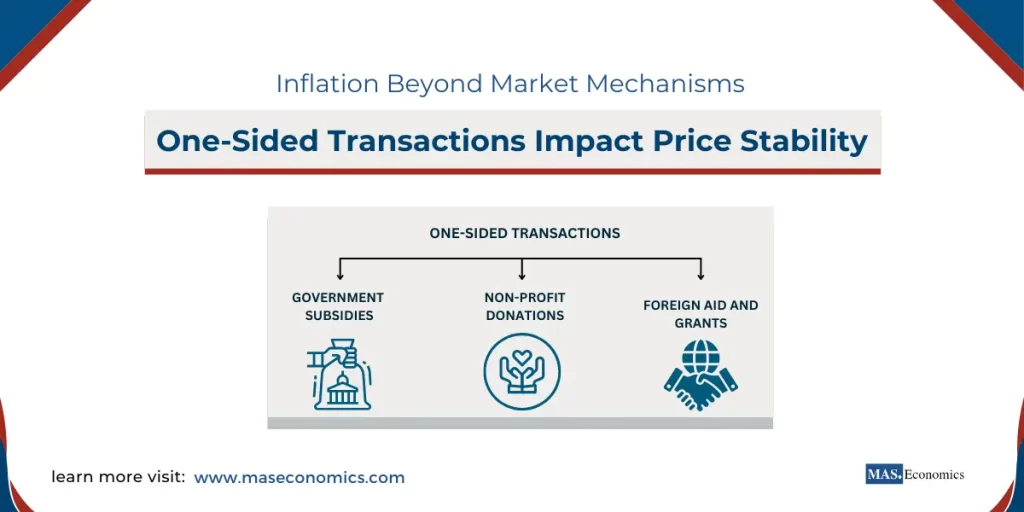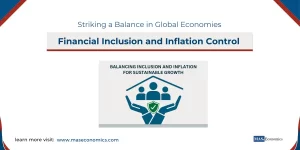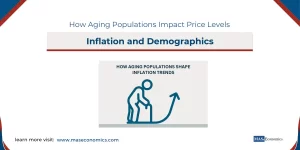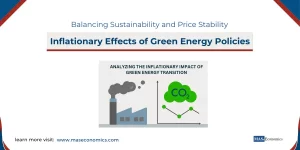Inflation is often explained through market forces—supply and demand, central bank actions, and fiscal policies. However, a less-discussed aspect of inflation involves one-sided transactions. These are exchanges where one party gives without receiving equivalent value in return, such as government subsidies, donations, and non-reciprocal aid. Though they may appear neutral or benevolent, these transactions can distort market dynamics and affect price stability, contributing to inflation.
One-sided transactions can significantly influence inflationary pressures and shape economic environments. Examining their impact on the broader market provides insight into the connection between these financial flows and inflation.
One-Sided Transactions Explained
One-sided transactions occur when one party provides resources without directly receiving anything of equivalent value in return. These transactions can take many forms, including:
- Government Subsidies: Financial support given to particular sectors without the expectation of immediate repayment.
- Non-Profit Donations: Contributions made to charitable causes, which lack the reciprocal exchange seen in typical market transactions.
- Foreign Aid and Grants: Government-provided or international financial aid that is non-repayable.
Unlike market-based transactions, which revolve around the concepts of exchange and negotiation, one-sided transactions do not operate under typical market forces. Instead, they are driven by policies, social needs, and external pressures, often bypassing the checks and balances that market exchanges typically enforce.
These transactions do not generate market signals that could help in adjusting prices or understanding demand. When injected into an economy in significant quantities, they can influence price levels without corresponding changes in production or supply, leading to imbalances that affect inflation.
Government Subsidies
Government subsidies are one of the most prevalent forms of one-sided transactions. They are typically implemented to promote growth in certain sectors, support struggling industries, or make essential goods more affordable to the public. However, while subsidies serve an important social and economic role, they can also have inflationary effects.
Case Study: Agricultural Subsidies and Food Prices
Consider agricultural subsidies. Governments often provide these to ensure food security, stabilize prices, or protect farmers from the volatility of global commodity markets. While such subsidies make food more affordable for consumers in the short term, they can also lead to increased demand that outpaces supply, putting upward pressure on prices.
In this way, agricultural subsidies can inadvertently contribute to inflation, especially when governments have difficulty scaling back support after the initial purpose has been served. Such sustained interventions often lead to inefficiencies in the market, where prices no longer reflect actual production costs but rather depend on subsidy-induced demand.
Foreign Aid and Inflationary Spillovers
Foreign aid, particularly non-repayable grants, represents another form of one-sided transaction that can contribute to inflation, particularly in developing economies. When an influx of financial aid enters an economy, especially when not matched by an increase in productive capacity, it can lead to inflationary pressures.
Example: Inflation Through Foreign Aid
Foreign aid often comes as a stimulus to developing nations, providing funding for infrastructure, healthcare, and education. However, the sudden injection of money into an economy, if not carefully managed, can lead to increased spending without corresponding productivity growth. This situation, known as the “Dutch disease,” happens when the receiving economy sees rising inflation due to increased demand without an accompanying increase in the supply of goods and services.
For instance, foreign aid provided to improve healthcare infrastructure can increase public spending and demand for construction and healthcare services. However, if local production capacity for these services does not rise at the same rate, the imbalance between supply and demand will push prices higher, leading to inflation.
Donations and the Distortion of Price Signals
Donations to charitable organizations also represent one-sided transactions that can have unintended inflationary consequences. This form of financial flow, although vital for social welfare, can distort market mechanisms by affecting supply and demand in unpredictable ways.
Consider a non-profit organization that receives a significant donation aimed at purchasing food supplies for impoverished communities. This donation can lead to a sudden surge in the demand for food products, pushing up prices in the local market if the supply remains stagnant. Such one-sided transactions, despite their humanitarian intentions, can inadvertently create price inflation, especially in small and isolated markets.
The Inflationary Effect of Subsidized Services
Subsidized services, such as education, healthcare, and public transport, also represent one-sided transactions with inflationary potential. Governments often provide these subsidies to promote equity and ensure that essential services are accessible to all citizens. However, these subsidies also disrupt market pricing.
Healthcare Subsidies: A Double-Edged Sword
Healthcare subsidies can reduce the out-of-pocket costs for individuals, increasing access to medical services. However, without an increase in healthcare providers or medical infrastructure, these subsidies can result in inflated costs due to heightened demand for limited services. The inflationary effect of these subsidies is often visible in developing economies, where the supply of qualified healthcare professionals cannot keep pace with subsidized demand.
Non-Reciprocal Aid and Monetary Supply Increases
Non-reciprocal aid, such as financial relief packages provided during times of crisis, can lead to inflation if these funds result in an increase in the overall money supply without a corresponding increase in goods and services. This situation was evident during the COVID-19 pandemic when numerous countries provided stimulus checks to sustain consumer spending. While these measures were necessary to avert economic collapse, they also contributed to inflation as increased spending was not balanced by an increase in production.
The Role of Fiscal Policy in Managing One-Sided Transactions
Fiscal policy plays a crucial role in managing the potential inflationary effects of one-sided transactions. To counterbalance the impact of subsidies, donations, and aid, governments must ensure that fiscal measures are accompanied by policies aimed at increasing productivity and managing aggregate demand.
Balancing One-Sided Transactions with Production Growth
To mitigate inflation, one-sided transactions must be complemented by productivity enhancements. For instance, if a government provides subsidies for agriculture, it should also invest in agricultural technology and infrastructure to ensure that production can keep pace with increased demand. Similarly, foreign aid should be strategically used to improve production capacities rather than simply fuel consumption.
One-Sided Transactions in the Context of Price Stability
The impact of one-sided transactions on inflation ultimately depends on the balance between the money supply and the production of goods and services. When financial flows, such as subsidies, aid, and donations, are not carefully managed, they can distort the delicate equilibrium of the market, leading to price instability.
The challenge for policymakers is to ensure that these transactions serve their intended social purposes without triggering inflationary spirals. This requires a comprehensive approach that takes into account the supply side of the economy, ensuring that subsidies and aid lead to improvements in productivity rather than merely boosting demand.
Conclusion
One-sided transactions are vital to modern economies, supporting vulnerable populations, stabilizing markets, and fostering growth, but they also pose challenges related to inflation and price stability. Understanding their mechanisms and potential economic effects allows for crafting interventions that minimize inflation risks while maximizing benefits. Achieving a balance between financial support and economic output is crucial for these transactions to positively contribute without destabilizing the economy. Governments and non-profits must consider long-term implications and align financial assistance with productive capacity to ensure subsidies, aid, and donations provide benefits without leading to inflation or economic instability.
FAQs:
What are one-sided transactions in economics?
One-sided transactions are financial exchanges where one party provides resources or funds without receiving an equivalent value in return. Common examples include government subsidies, charitable donations, and foreign aid. These transactions differ from market-based exchanges, which typically involve reciprocal value, and can affect inflation by distorting market dynamics.
How do government subsidies impact inflation?
Government subsidies, such as those for agriculture or energy, can increase demand by making certain goods or services more affordable. However, if subsidies drive demand beyond supply capabilities, they can cause price levels to rise, leading to inflation. Over time, subsidies may also create inefficiencies, making markets more reliant on government support and distorting natural price signals.
Can foreign aid contribute to inflation in recipient countries?
Yes, foreign aid can lead to inflation, particularly if it stimulates demand without boosting production capacity. In some developing countries, foreign aid inflows raise the demand for goods and services, which, if not matched by local supply, can lead to higher prices. This situation, often referred to as the “Dutch disease,” can result in inflationary pressures due to the imbalance between demand and supply.
How do donations and charitable funding affect local prices?
Large-scale donations, especially when directed toward goods like food or housing in a specific region, can increase demand, potentially driving up local prices if supply remains limited. For instance, if a non-profit purchases large quantities of food for distribution, prices may rise in response to the increased demand, which can inadvertently affect the purchasing power of local consumers.
What inflationary effects can arise from subsidized services?
Subsidized services, such as healthcare and education, lower costs for users, which can increase demand for these services. If there is not a matching increase in supply (e.g., healthcare professionals, medical infrastructure), the demand can lead to higher overall costs. This demand pressure can contribute to inflation, especially in sectors where resources are already limited.
Why can non-reciprocal aid contribute to inflation?
Non-reciprocal aid, like relief funds or financial aid, can increase the money supply and consumer spending without a corresponding rise in goods or services. For example, during crises, governments may distribute stimulus checks to support households, but if production cannot meet this heightened demand, inflation can result from the excess liquidity in the economy.
How can fiscal policy help manage inflation from one-sided transactions?
Effective fiscal policy can help by balancing demand-driven effects of one-sided transactions with supply-side growth. Policies that accompany subsidies or aid with investments in infrastructure and productivity help align increased demand with output, reducing inflation risks. For instance, subsidies in agriculture can be paired with technological support to boost food production, counterbalancing inflationary pressures.
What is the “Dutch disease” and how is it related to inflation?
The “Dutch disease” refers to the inflationary effect in an economy due to large inflows of foreign aid or resource revenues that increase demand without boosting production. This term originally described the impact of natural gas exports on the Netherlands but applies to other contexts where an influx of external funds drives up local prices due to a supply-demand imbalance.
Thanks for reading! Share this with friends and spread the knowledge if you found it helpful.
Happy learning with MASEconomics




